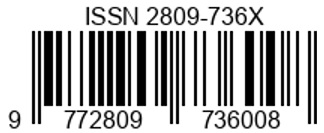SQ3R STRATEGY IN TEACHING READING
Abstract
This research was aimed: To find out significant effect of using SQ3R in teaching reading at the eighth-grade students of SMPN 1 Buer. The kind of this research was quantitative research. The sample of this research was the eighth-grade students of SMPN 1 Buer that consist of 60 students. The instrument of collecting data used test which was 25 multiple choice items. In this research, the researcher gave a treatment and prepared a test in form of multiple choices to look for the effect of using SQ3R strategy. The result of the data analysis indicated that the students of SMPN 1 Buer attained high score on the post test for experimental group who were treated by using SQ3R strategy. It was provable that t-test was higher than t-table, which was the value of t-test was 1.733 and t-table in df 0.05 was 1.671. It means that the use of SQ3R strategy gave a significant effect in teaching reading at the eighth-grade students of SMPN 1 Buer. It was proven by the lowest and highest score in pre-test for experimental group, they were 28 and 60 and posttest were 32 and 72. For the control group in the pre-test gained the lowest and the highest score were 28 and 60 and posttest in lowest and highest scores were 28 and 60. Then, the result of hypothesis testing that the alternative hypothesis was accepted. In other words that teaching reading using SQ3R strategy at the eighth-grade students of SMPN 1
References
[2] http://etd.ohiolink.edu/send.pdf.cgi/Baier%20Kylie.pdf. Accessed on 27 October 2012.
[3] Burke, J. 2000. Reading Tools, “Tips, and Technique Reminders. Portsmouth: Boynton/Cook Publisher.
[4] Brown, H. Douglas. 2003. Language Assessment : Principles and Classroom Practices. San Francisco University: Longman.
[5] Candiasa, I M. 2010. Penguji Instrument Penelitian Disertai ITEMAN dan BIGSTEPS. (Thesis K.Dedy Sandiarsa S. 2013).
[6] Erawati, L. P. E. P. 2012. A Comparative Effect of Metacognitive Self-Monitoring Strategies on Students’ Reading Competency Based on Text Types. Unpublished Thesis. (Thesis K.Dedy Sandiarsa S. 2013).
[7] Gerald G. Duffy. 2009. Explaining reading a resource for teaching concepts, skills, and strategies 2nd edition.pdf. New York London. The Guilford Press.
[8] Hallman, Jenna. 2009. Reading Aloud: Comprehending, NotWord Calling . South Carolina.
[9] Hornby, A.S. 1995. Advance Learner’s Dictionary of Current English. Oxford. University Press. (Thesis Rudi Hamsah 2007)
[10] Hue, N. T. 2011.Use of SQ3R Technique in Enhancing English Reading Skills of Second Year Students. Thesis. Philippines: Southern Luzon State University. http://itcnu.edu.vn/Uploads/Thesis/162_98_Janerprelim%20page-final%20copy.pdf. (Thesis K.Dedy Sandiarsa S. 2013).
[11] Johnson, P. Andrew. 2008. Teaching and Writing a Guidebook for Tutoring and Remediating Student. United States of America: Rowman & Littlefield Publishers, Inc
[12] Karolina, I. 2006. Teaching Narrative Text in Improving Writing to the Tentth Grade Students of SMA Negeri 1 Petarukan, Pemalang. Thesis. Semarang: Universitas Negeri Semarang. http://aguswuryanto.files.wordpress.com/2011/10/ptk-teaching-narrative-sma-petaruan.pdf. Accessed on 22 October 2012
[13] Kothari, C. R. 2004. Research Methodology. Methods and Technique (2nd Received Edition). Jaipur. New age International.
[14] Leipzig, D. H. 2001. What is reading? .http://www.readingrockets.org/article/352. Accessed on 12 October 2012.
[15] Liu, F. 2010.”A short Analysis of the Nature of Reading: Canadian Center of Science and Education”.Journal of English Language Teaching Vol. 3, No. 3; September 2010. www.ccsenet.org/elt. Accessed on 04 October 2012.
[16] Mabakejo, O. 2011. “Effects of S-Q-3-R and 3-S-3-R Study Strategies on Senior Secondary School Students’ Academic Achievment in Reading Comprhension”. Journal of the Nigeria English Studies Association (JNESA) 14:2. http://www.nigeriaenglish.com/content/v14/2/ola.pdf. Accessed on 27 October 2012.
[17] Marczyk. G. 2005. Essential of Research Design and Methodology. United States of America: TEAM LinG - Live, Informative, Non-cost and Genuine.
[18] Paris, S. G. 2005. “Reinterpreting the development of readimg skills”. Journal of Reading Research Quarterly Vol. 40, No. 2 April/May/June/2005.
[19] http://www.google.co.id/url?sa=t&rct=j&q=pdf. Accessed on 13 November 2012.
[20] Patel, Jain Praveen M. 2008. English Language Teaching Method. Jaipur: Sunrise Publishers and Distributors.
[21] Shihab. A. I. 2011. “Reading as Critical Thinking”.Journal of Asian Social Science .Vol. 7, No. 8; August 2011. www.ccsenet.org/ass. Accessed on 04 October 2012.
[22] Sugiyono. 2010. Statistik Untuk Penelitian. Bandung: Alfabeta.
[23] Stone, R. 2009. Best Practices for Teaching Reading: What Award-Winning Teachers do. USA: Corwin Press.
[24] Walker, B. J. 2008. Diagnostic Teaching of Reading: Techniques for Instruction and Assessment (6th ed). Ohio: Pearson Education Ltd. (Thesis K.Dedy Sandiarsa S. 2013)
[25] Wright,D. 2003. SQ3R: Method of Study. http://www.pent.ca.gov/acc/SQ3Rmethodofstudy.pdf. Accessed on 28 October 2012.
[26] Yogesh Kumar, Singh. 2006. Fundamental of Research Methodology and Statistics. New Delhi: New Age International Limited Publishers.













